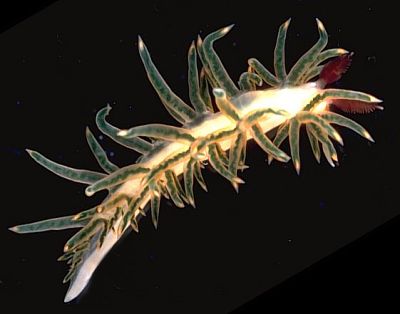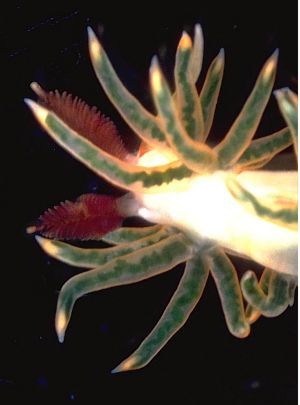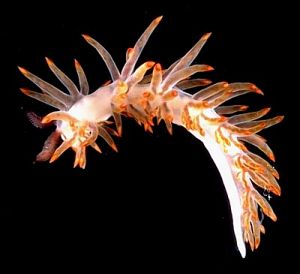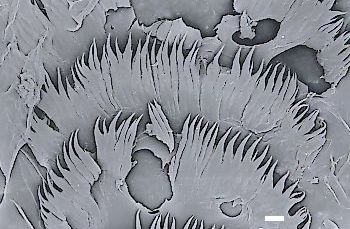
Burnaia helicochorda
(Miller, 1988)
Order: NUDIBRANCHIA
Suborder: AEOLIDINA
Family: Aeolidiidae
DISTRIBUTION
Northern New Zealand, New South Wales, Australia.
PHOTO
Green and Orange colour forms. Pilot Beach, Laurieton, New South Wales, Australia. 4 November 1979. AM C118699. 18-23mm long alive. Photos: John Fields.
Body translucent white with orange H pattern on the head. Relatively sparse cerata arranged anteriorly in arches and posteriorly in rows. Cerata either elongate and pointed as in photos or contracted and inflated with a series of annuli near the tip. There is a subapical orange band around the cerata. Digestive gland either bright brownish orange or green, and forms an irregular spiral inside the ceras. The name helicochorda refers to the spiral digestive gland duct. The reddish brown rhinophores are perfoliate.
First described from northern New Zealand as Aeolidia helicochorda it has been found a few times in New South Wales in eastern Australia.
See Radula photos.
Reference:
• Miller, M.C. (1988) Aeolidia helicochorda, a new aeolid nudibranch (Gastropoda: Opisthobranchia) from New Zealand. New Zealand Journal of Zoology, 14 (for 1987): 391-397.
• Miller, M.C. (2001) Aeolid nudibranchs (Gastropoda: Opisthobranchia) of the family Aeolidiidae from New Zealand waters. Journal of Natural History, 35(5): 629-663.


Rudman, W.B., 2001 (June 20) Burnaia helicochorda (Miller, 1988). [In] Sea Slug Forum. Australian Museum, Sydney. Available from http://www.seaslugforum.net/find/burnheli
Related messages
Re: 'Aeolidia' helicochorda
June 23, 2001
From: Irina Roginskaya
Dear Bill,
I am sorry, I do not understand why the green creature in front of the message of Nishina Masayoshi, with perfoliate rhinophores and long, cylindrical, not leaf-like, cerata is called Aeolidia?
Best wishes.
Irina Roginskaya.
irina7@hotmail.com
Roginskaya, I, 2001 (Jun 23) Re: 'Aeolidia' helicochorda. [Message in] Sea Slug Forum. Australian Museum, Sydney. Available from http://www.seaslugforum.net/find/4653Dear Irina,
Your wish is granted! It is no longer in the genus Aeolidia. I was calling the animal 'Aeolidia' because that is where Michael Miller provisionally placed it when he described it in 1987. He planned to publish a revision of the family soon after. Richard Willan's message today informs us that Michael's revision is at last published and the 'green creature' has been removed to a new genus Burnaia.
Best wishes,
Bill Rudman
Radula of Aeolidia helicochorda
June 22, 2001
From: Bill Rudman


Hare are some SEM photos of the radula of Aeolidia helicochorda. AM C118699. Pilot Beach, Laurieton, New South Wales, Australia. 18mm long alive. Upper photo showing two new teeth, Lower photo showing three of the oldest teeth. Scale bar = 10 microns. Photos: G. Avern.
The radular morphology, consisting of a single broad multidenticulate tooth in each row is typical of the family Aeolidiidae. Another characteristic is how each new tooth is significantly broader than the one preceeding it, so that the youngest tooth can be more than 5 times the width of the oldest tooth.
Best wishes,
Bill Rudman
